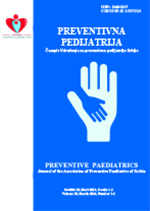CESAREAN SECTION AS A RISK FOR BRONCHIOLITIS IN EARLY CHILDHOOD
DOI:
https://doi.org/10.46793/PP250217012JKeywords:
infant, bronchiolitis, cesarean section, pregnancy, risk factorAbstract
Introduction: Acute bronchiolitis is one of the most common lower respiratory tract diseases in children during the first year of life and a frequent reason for hospitalization of young children during the winter period. In 75% of cases, it is caused by the respiratory syncytial virus (RSV). A more severe clinical course of acute bronchiolitis is expected in younger children, those born preterm, and children with underlying conditions.
Aim: To determine whether there is a correlation between cesarean section and the increased incidence of bronchiolitis in children up to one year old in the municipality of Doljevac.
Material and methodology: The study group consisted of 80 children, 36 boys and 44 girls, aged up to 1 year, with an average age of 8.2 months, diagnosed with bronchiolitis between October 2024 and January 2025. A questionnaire was completed by the mothers, and the collected data was statistically processed to determine possible correlations.
Results: Among the total number of children with bronchiolitis under the age of one, it was found that 28 (35%) were born through spontaneous vaginal delivery, while 52 (65%) were born via cesarean section.
Conclusion: Since this is a retrospective study, we lacked information on whether the cesarean sections were performed electively or as emergency procedures. Our research will open many avenues for larger and more in-depth studies. Cesarean delivery appears to increase the risk of bronchiolitis when compared to babies born via vaginal delivery.
References
Eldrian F, Liana N, Aditia Permana Y, Lismawati, Helmizar R. Profil Respiratory Distress Pada Bayi Baru Lahir Di Nicu RSIA Siti Hawa Padang Tahun 2021. Nusantara Hasana Journal, 2024:3(12),79–86. doi:10.59003/nhj.v3i12.1121.
Yuliani I, Sophia Sondakh J, Yulifah R. Are Children Born By Sectio Caesarea (SC) Correlated with Respiratory and Autoimmune Diseases? Jurnal Kebidanan Dan Kesehatan Tradisional 2022;7(2):148–155. doi:10.37341/jkkt.v0i0.374.
Słabuszewska-Jóźwiak A, Szymański JK, Ciebiera M, Sarecka-Hujar B, Jakiel G. Pediatrics Consequences of Caesarean Section-A Systematic Review and Meta-Analysis. Int J Environ Res Public Health. 2020;17(21):8031. doi: 10.3390/ijerph17218031. PMID: 33142727.
Carbonell-Estrany X, Fullarton JR, Gooch KL, Vo PG, Figueras-Aloy J, Lanari M, et al. Effects of parental and household smoking on the risk of respiratory syncytial virus (RSV) hospitalisation in late-preterm infants and the potential impact of RSV prophylaxis. J Matern Fetal Neonatal Med. 2013;26(9):926-931. doi: 10.3109/14767058.2013.765850. PMID: 23379728.
Efriza E, Um P, YH, G. Gambaran Faktor Risiko Respiratory Distress Syndrome Pada Neonatus Di Rsup Dr M. Djamil Padang. HEALTHY: Jurnal Inovasi Riset Ilmu Kesehatan, 1(2), 73-80. https://doi.org/10.51878/healthy.v1i2.1064
Martinez FD. Respiratory syncytial virus bronchiolitis and the pathogenesis of childhood asthma. Pediatr Infect Dis J. 2003;22(2 Suppl):S76-82. doi: 10.1097/01.inf.0000053889.39392.a7. PMID: 12671456.
Meissner HC. Viral Bronchiolitis in Children. N Engl J Med. 2016 ;374(1):62-72. doi: 10.1056/NEJMra1413456. PMID: 26735994
Savić N, Janković B, Minić P, Vasiljević Z, Sovtić A, Pejić K, et al. Clinical characteristics of respiratory syncytial virus infection in neonates and young infants. Vojnosanit Pregl. 2011;68(3):220-224. doi: 10.2298/vsp1103220s. PMID: 21524004.
Oberg M, Jaakkola MS, Woodward A, Peruga A, Prüss-Ustün A. Worldwide burden of disease from exposure to second-hand smoke: a retrospective analysis of data from 192 countries. Lancet. 2011;377(9760):139-146. doi: 10.1016/S0140-6736(10)61388-8. PMID: 21112082.
Papoff P, Moretti C, Cangiano G, Bonci E, Roggini M, Pierangeli A, et al. Incidence and predisposing factors for severe disease in previously healthy term infants experiencing their first episode of bronchiolitis. Acta Paediatr. 2011;100(7):e17-23. doi: 10.1111/j.1651-2227.2011.02181.x. PMID: 21284715.
Nenna R, Cutrera R, Frassanito A, Alessandroni C, Nicolai A, Cangiano G, et al. Modifiable risk factors associated with bronchiolitis. Ther Adv Respir Dis. 2017;11(10):393-401. doi: 10.1177/1753465817725722. PMID: 28812472.
Atay Ö, Pekcan S, Göktürk B, Özdemir M. Risk Factors and Clinical Determinants in Bronchiolitis of Infancy. Turk Thorac J. 2020;21(3):156-162. doi: 10.5152/TurkThoracJ.2019.180168. PMID: 32584231.
Frassanito A, Nenna R, Arima S, Petrarca L, Pierangeli A, Scagnolari C, et al. Modifiable environmental factors predispose term infants to bronchiolitis but bronchiolitis itself predisposes to respiratory sequelae. Pediatr Pulmonol. 2022;57(3):640-647. doi: 10.1002/ppul.25794. PMID: 34918490.
Walsh R, Costello L, DiCosimo A, Doyle A-M, Kehoe L, Mulhal C, et al. Bronchiolitis: evidence-based management in high-risk infants in the intensive care setting. Pediatr Res 2024;96:1560–1567. https://doi.org/10.1038/s41390-024-03340-y
Moore HC, de Klerk N, Richmond P, Lehmann D. A retrospective population-based cohort study identifying target areas for prevention of acute lower respiratory infections in children. BMC Public Health. 2010;10:757. doi: 10.1186/1471-2458-10-757. PMID: 21138593.
Huh SY, Rifas-Shiman SL, Zera CA, Edwards JW, Oken E, Weiss ST, et al. Delivery by caesarean section and risk of obesity in preschool age children: a prospective cohort study. Arch Dis Child. 2012;97(7):610-816. doi: 10.1136/archdischild-2011-301141. PMID: 22623615.
Liu X, Zhang J, Liu Y, Li Y, Li Z. The association between cesarean delivery on maternal request and method of newborn feeding in China. PLoS One. 2012;7(5):e37336. doi: 10.1371/journal.pone.0037336. PMID: 22624019.
Parlar-Chun R, Hafeez Z. Association of Socioeconomic Factors and Severity of Bronchiolitis Hospitalizations. Clin Pediatr (Phila). 2024;63(2):201-207. doi: 10.1177/00099228231200393. PMID: 37705196.





